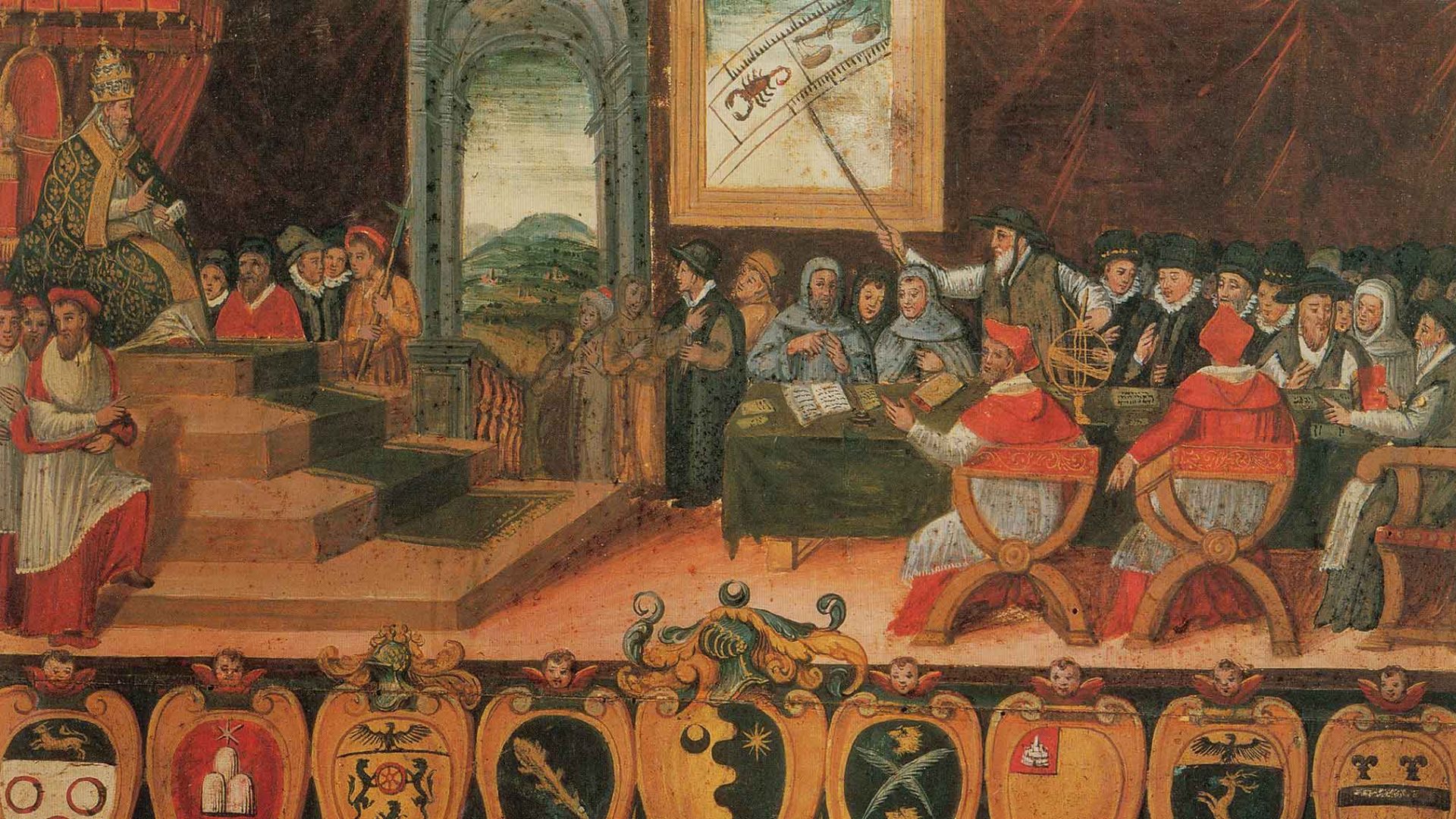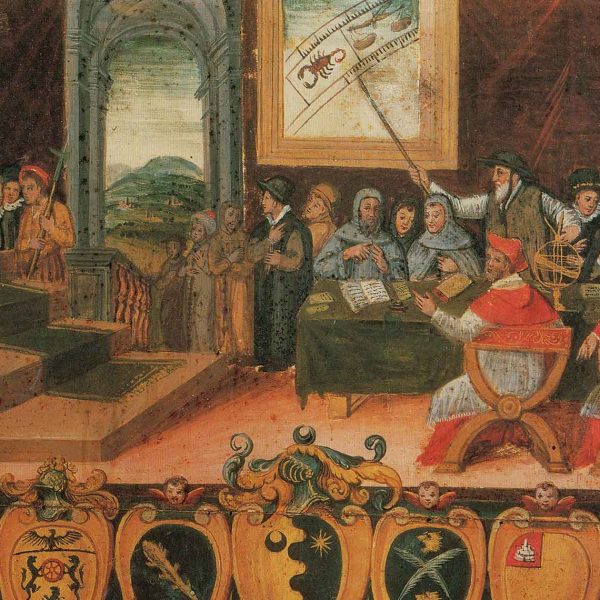
via del Monte 8, Bologna (Italy)
t +39 051 236760
info@palazzoboncompagni.it
Palazzo Boncompagni is social

Perhaps its most important legacy – certainly the one that touches everyone closely – is the calendar. In fact, the rule that marks our time in days, months and years dates back to Gregory XIII. The invention of the Gregorian calendar is a real adventure involving, in addition to the Pope, many scientists and clergymen: a scientific challenge to put back on axis the time of men with that of the planet. A political and religious challenge to convince everyone – Catholics and Protestants alike – to accept it.

When we learn from the historical chronicles that Teresa of Avila died during the night between October 4th and 15th 1582, one is tempted to immediately think of one of the many supernatural phenomena that characterized the life of the Spanish saint. In reality, this time there was nothing supernatural. Millions of people in Europe experienced that strange night in 1582.
They went to sleep on the evening of Thursday 4th October and woke up on the morning of Friday 15th October. Why was there a ten-day gap in the calendar? And above all: who was to decide such an extraordinary measure? We will immediately say that the decision was made by the reigning Pope Gregory XIII, the Bolognese Ugo Boncompagni, who since 1572 had sat on the throne of Peter.
This provision was developed by astronomers and theologians of his court, driven by the observation that the counting of time was now out of control and was going to have a very negative impact on the liturgical life of the Church. Let’s try to understand what happened.
Christian Europe had used the calendar imposed by Julius Caesar in 45 BC for centuries, which he called the Julian Calendar.
This calendar had calculated that the cycle of the seasons had a duration of 365 days and 6 hours. In reality the cycle of the seasons lasts 365 days, 6 hours, 48 minutes and 4 seconds. The Julian calendar therefore accumulated 11 minutes and 14 seconds of delay each year with respect to the natural path of the sun. And after 128 years the accumulated delay was already one day.
But at the time of Gregory XIII, sixteen centuries after its introduction, the Julian calendar had accumulated a delay of 13 days with respect to the course of the sun. For Christians, this delay was no small thing. Many centuries earlier, in the year 325, the Council of Nicaea had established that the date of Easter should fall on the first Sunday after the spring full moon, but due to the delays accumulated in the Julian calendar, at the time of Gregory XIII, the solar spring had already began on March 11th and not on March 21st, thus causing many problems in defining the date of the celebration of Easter.
A remedy had to be taken by acting on two fronts: on the one hand to realign the civil and ecclesiastical calendar to the natural course of the sun and the seasons, while on the other hand to modify the average length of the year in order to prevent the problem of an accumulation of delay. It was no small job. Gregory XIII appointed a commission of experts chaired by the bishop of Sora Tommaso Giglio, who was later succeeded by Cardinal Guglielmo Sirleto.
The commission was composed of mathematical astronomers, doctors, liturgist cartographers, theologians, experts in patristics, ecclesiastical chronology, oriental languages and canon, and civil law. Among these the figures of the Dominican Ignazio Danti and the Jesuit Cristoforo Clavius stood out. The members of this commission worked for a long time until they came up with a summary document in the form of a Compendium.
Through the network of apostolic nuncios, Pope Gregory sent the Compendium to the kings and princes of the Earth and to all the universities of the Catholic world to be submitted to the opinion of astronomers, mathematicians and theologians far from Rome. Taking into account the judgments received, the Roman Commission drew up a new report, dated 1580, in which the corrections and indications received were taken into account. Finally, on February 24th 1582, Gregory XIII Boncompagni issued the solemn bull Inter gravissimas from Frascati, which contained the new calendar rules for the whole Catholic world.
“Gregory, bishop, servant of the servants of God, for everlasting memory (…) We therefore, to carry out what belongs to the pontiff maximum, approve with this decree of ours this calendar, reformed and made perfect by the immense kindness of God to his Church, and we command that it be printed in Rome together with the martyrology, and that it be then divulged. (…) So let’s remove the old calendar and we want all patriarchs, primates, archbishops, bishops, abbots and other heads of the Church to introduce the new calendar. (…)
Its use will begin after the ten days abolished from the month of October 1582 (i.e. October 15th). To those who live in regions so far away that they cannot have news of this letter before the time prescribed by us, it is legitimate to make the change in the same month of October of the following year 1583. (…)
Indeed, since it would be difficult to send this letter to all places in the Christian world, it will be posted on the doors of St. Peter’s Basilica and those of the Apostolic Chancellery, and in the square of Campo de ‘Fiori. (…)
No one is therefore permitted to transgress this page containing our precepts, commands, orders, wills, approval, prohibition, exhortations and requests, nor dare to oppose them. And if anyone presumes to try, know that he will incur the wrath of the Almighty and the holy apostles Peter and Paul.
Given in Frascati, February 24th 1581, the tenth year of our pontificate.”
In essence, the papal bull argued with, as we have seen, rather imperious tones, that the day of Thursday 4th October of that year 1582 should be directly followed by the day of Friday 15th October. The Pope had thus suddenly canceled ten days from the current year. Not only that, the bull also changed the rules on leap years. Up to that moment, every four years, an extra day was added, on February 29th, to count 366 days.
Gregory instead established that the years ending the century, that is 1600, 1700, 1800, etc., would no longer be leap years, except for those divisible by four. That is, 1600 was a leap, 2000 was a leap, thus eliminating one day on average every 125 years, more or less compensating for the 11 minutes and 14 seconds per year of delay from the old Julian calendar.
The new calendar was named the Gregorian Calendar after the pope and was immediately accepted by almost all Catholic countries: Italy, France, Spain, Portugal, Poland, Lithuania, Belgium, the Netherlands and Luxembourg. But other Catholic countries such as Austria, Bohemia and Moravia took more time and joined a few years later. The Protestant countries that later adhered to the reform wanted by Gregory XIII proved, at various times, to be decidedly hostile to the new papist calendar. The Lutheran and Calvinist states aligned themselves in 1700, the Anglican ones in 1752 and those of Orthodox culture even later. In reality, the Russian, Serbian and Jerusalem Orthodox Churches still continue to follow the Julian calendar, hence the difference of 13 days between the Orthodox holidays and those of other Christian denominations.
Non-Christian countries adopted the Gregorian calendar between the 1800s and 1900s. Japan introduced it in 1873, China in 1912 and Turkey in 1924. Russia adopted the Gregorian calendar in 1918, but changed its mind in 1923 and introduced the Soviet revolutionary calendar. However, this experiment did not last very long. In 1940, this calendar was abandoned and they returned to the much more experienced calendar of Gregory XIII.
The clear cancellation of ten days from the calendar in 1582 caused more than a few practical and immediate problems. Aside from the strange case of the death of Saint Teresa of Avila, remember that she died between October 4th and 15th, there were quite important questions, for example, on the front of payments and deadlines: how to deal with rents, wages and contracts that had already been established for some time connected to those dates?
The Pope threw this hot potato, so to speak, into the hands of the civil authorities. In the bull he established that “It will be up to the judges, in any disputes, to take this subtraction into account by adding another ten days to the end of each performance”. So it would have been the courts, in the last resort, who would have taken action to unravel the problem.
Gregory XIII took upon himself the question of the saints who were celebrated in the days suppressed by the new calendar.
The solution came quickly: the saints Dionysius, Rustico, Eleuterio, Sergio, Bacchus, Marcello, Apuleio and Callisto would be distributed and celebrated on other dates.
The Pope forgot one last detail: what would be done for those who celebrated a birthday in 1582 between October 5th and 14th, as he would have done? Nothing. The Pope would do nothing. They would have to celebrate the following year and skip the occasion in 1582.
Gregorius: Ugo Boncompagni, A Great Bolognese Pope.
A podcast in three written episodes narrated by Marco Carminati and directed by Ottavia Casagrande